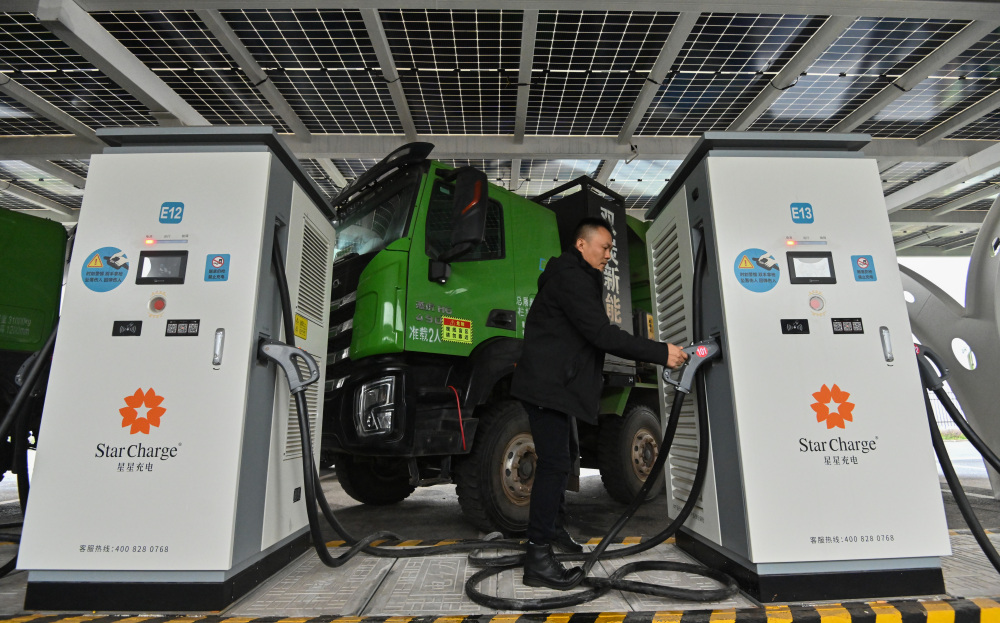 Bridging News
Bridging News
Chongqing Unveils Cutting-Edge Supercharging Station for NEVs and Trucks
Chongqing - The Longma Super Charging Station in Chongqing High-Tech Zone, launched on January 2, is the city's most advanced supercharging facility, capable of charging 180 new energy vehicles (NEVs) and accommodating 40 heavy trucks for battery swaps at once.
Longma station boasts a total charging capacity of 22,000 KVA and features a 20 MW electrochemical energy storage setup. It represents an integrated demonstration site combining photovoltaic power generation, energy storage, charging and discharging, battery swapping, and testing.

Longma Super Charging Station is located in Shiban town, Chongqing High-Tech Zone. (Photo/Long Fan)
Reduce carbon emissions by about 500 tons yearly
The Longma station boasts 87 charging devices, including 480kW DC liquid-cooled, 360kW split-type DC, and 240kW and 180kW DC charging piles, totaling a combined charging power of 19,920kW.
The battery swap station, with a reserve of eight 282kWh power batteries, can simultaneously charge NEVs and cycle battery swaps for heavy trucks.
"The battery swapping process is guided by infrared and autonomous decision-making, allowing for a rapid 5-minute swap in unattended conditions, significantly enhancing the operational efficiency of new energy heavy trucks," said Zhou Shipeng, director of the New Infrastructure Division of the Chongqing Science City (Urban) Operations Group Co., Ltd.
Longma station utilizes both grid and photovoltaic power. Its 3,500 square-meter carport photovoltaic system has a 0.7 MW capacity, producing over 500,000 kWh yearly. This setup, supporting daytime charging of new energy-heavy trucks, enables direct power usage and cuts carbon emissions by about 500 tons yearly.

The constructed carport photovoltaic area reaches 3500 square meters. (Photo/Long Fan)
Reverse discharging in different scenarios
Notably, the Longma station is also equipped with a Vehicle-to-Grid (V2G) charging system, enabling interactive energy transfer between NEVs and the electric grid.
NEVs at Longma station act as "mobile power banks," capable of reverse discharging to energy storage systems, buildings, and charging piles. Owners can profit by selling surplus electricity back to the grid, creating an interactive mobile energy network between vehicles and the grid.
"For example, if we calculate using a 60 kWh battery pack of a new energy vehicle, charging at night with residential electricity costs about 0.35 yuan/kWh and discharging during the day at an average of 1.2 yuan/kWh, the owner can earn a profit margin of approximately 0.85 yuan per kWh," said Zhou. If a vehicle discharges 50% during the day, it can theoretically earn about 25.5 yuan daily.
The Longma station features a 20 MW electrochemical energy storage system, enabling it to function independently through its storage and V2G systems. For example, it can effectively provide emergency power to maintain the surrounding community's daily life and critical operations and essential equipment.
Furthermore, the station employs a smart energy management system featuring an on-site platform that displays real-time charging data. This includes daily and cumulative charging volumes, charge counts, frequency and time distributions, and vehicle types, offering comprehensive insights into the station's operations.

A truck driver is charging his truck at the Western (Chongqing) Science City Kecheng Zhichong·Longma Supercharging Station. (Photo/Long Fan)
"Relying on foundational technologies like the Internet of Things, 5G, cloud computing, and big data analysis, the smart energy monitoring platform enables real-time, online, and intelligent data management of the site," Zhou added.
Western (Chongqing) Science City aims to become a hub for energy storage system integration and a cluster for the energy storage industry, striving to achieve a production value of over 12 billion yuan (about USD 1.69 billion) by 2024.
 Related Stories
Related Stories